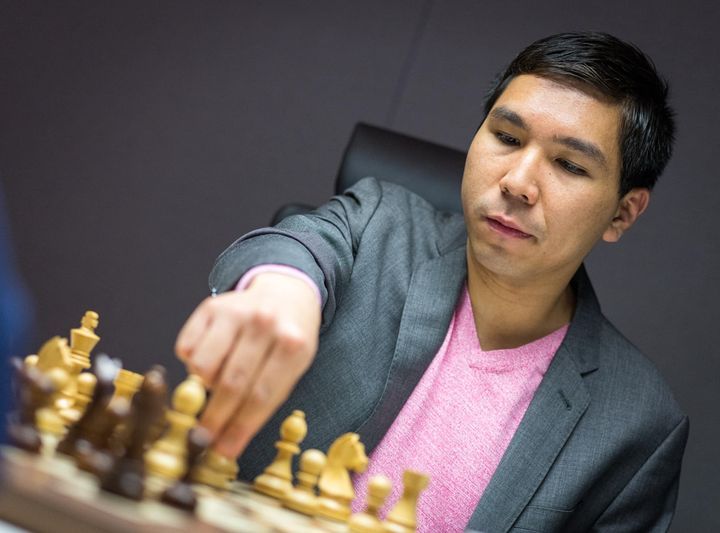
Anand, Wesley So Take Lead: 2022 Norway Chess, Day 1
After Monday's fun and exciting blitz tournament, the real play started in this year's edition of Norway Chess on Tuesday.
With victories with the white pieces, GMs Viswanathan Anand and Wesley So won their respective games against GMs Maxime Vachier-Lagrave and Teimour Radjabov. The other games ended in draws, thus leaving Anand and So in the lead after the first round.
How to watch?
You can follow the 2022 Norway Chess with expert commentary on Chess.com/TV or on our Twitch channel. You can also catch all our live broadcasts on YouTube.com/ChesscomLive.
Follow the 2022 Norway Chess games live on our dedicated page on Chess.com/events.
Let's introduce the ground rules for the tournament because, while it is a classical tournament, it also has a bunch of peculiar nuances.
- The tournament is a round-robin event with armageddon.
- Each player will have 120 minutes on the clock with an increment of 10 seconds after move 40.
- If there is a draw in the classical game, then the players will move on to armageddon within 20 minutes after the draw.
- White pieces will continue with White in Armageddon (with this, there will be a winner in each game because the black pieces will win if the game ends in a draw).
- White has 10 minutes and black has 7 minutes with an increment of one second per move, starting from move 41.
-
Players will get the following points per round. Victory in the main game: three points, loss in the main game: zero points, draw in the main game and victory in the armageddon: one and a half points, and a draw in the main game and loss in the armageddon: one point.
The pairings for the first round were established after the blitz tournament Monday evening.
So-Radjabov
By winning the blitz tournament, So won the right to be the first to pick his starting number, whereas Radjabov, who finished last in the blitz event, received the starting number that remained.
In the currently super-popular Italian Game, Radjabov, as Black, followed a game that So had played in the recent Bucharest tournament, only departing on move 13 and seemed to equalize. However, some inaccuracies on moves 16 and 18 gave White a better position. So carefully nurtured this into something more concrete, and in the early middlegame, it became clear that White was much better.

Radjabov, however, did his best to stir the pot, and had it not been due to a brilliant move by So on move 35, Black would have recovered fully. Alas, that was not to be and the American converted his advantage confidently.
Carlsen-Wang Hao
It seemed the players were in agreement to quickly depart from mainstream opening theory when they went for 1.Nf3 d5 2.g3 Nd7, although this particular setup has become quite common in the last few years.
GM Magnus Carlsen navigated the unusual opening rather better than GM Wang Hao and gained a solid advantage. However, a couple of imprecise moves by White and excellent defensive play by Black saw White's advantage vanish into clear, clean, and crisp Stavanger air.
In the armageddon game, Carlsen opted for the Catalan Opening, a weapon that has served him exceptionally well since the world championship match last year against GM Ian Nepomniachtchi.
The players followed one of Carlsen's online games against Nepomniachtchi, and the computer claimed that Black had equalized. Butr Black's position is strategically more complex to play, leaving White with some initiative.

This initiative eventually grew into something more tangible, and with Wang running increasingly more hopelessly into time trouble, the advantage grew. However, Carlsen, with much more time on his clock, played less than accurately, possibly in an attempt to confuse Wang. While it did not pay off initially, Carlsen received the reward just before Wang would start receiving the increment, allowing White a simple path to a won endgame.
Giri-Topalov
In a Catalan Opening, GM Anish Giri went for a line that he has previously played on a couple of occasions in both over-the-board and online events. In this line, White gives up his bishop pair and takes on a doubled f-pawn, and in return, he has excellent control of the center.
GM Veselin Topalov, however, seemed well-prepared and equalized without too many problems. Soon the game was headed toward the draw.
In the armageddon game that followed twenty minutes later, Giri repeated openings, but Topalov tried something different on move 11, albeit with less success than in their classical game. White gained a slight advantage and eventually won a pawn. The win, however, was still far from a certainty, but after several mistakes, White eventually won the game.
Anand-Vachier Lagrave
As the commentator duo of IM David Pruess and GM Arturs Neiksans agreed during the broadcast, the Indian grandmaster solved the problem of the Najdorf by avoiding it altogether. Anand chose the Moscow Attack 3.Bb5+, which is not the most threatening option for Black, but at the same time, it avoids all the theory and analysis that the high priest of the Najdorf religion, Vachier-Lagrave, has stored up in databank/secret scripture.
The play developed into a version of the Maroczy Bind where the light-squared bishops had been exchanged, something that has been played well more than 2000 times in my database, but eventually Anand veered off the main course with his 12.Nb3, which had only been played in a handful of prior games. The Frenchman had the opportunity to play the desirable ...d6-d5 break on move 16, but let the opportunity slide in favor of the other typical break ...b6-b5 on move 17, which unfortunately was not nearly as effective nor nearly as good. After White's 21.Qd2!, White took control of the game and won a pawn.
Despite Vachier-Lagrave's best efforts to resist, Anand converted the advantage with a steady hand, never letting the French grandmaster see a sliver of hope.
Mamedyarov-Tari
With GM Richard Rapport's withdrawal from the tournament just four days before the event was to start, Norwegian GM Aryan Tari got the opportunity to join in once more. In the blitz event, he demonstrated that he was not easily dismissed by scoring 4.5 points, including a victory over GM Shakhriyar Mamedyarov in brutal fashion, albeit with the white pieces.
In Tuesday's round, however, Mamedyarov had the white pieces. The players followed Mamedyarov's game against Firouzja from the recent Bucharest tournament. On move 14, Mamedyarov departed from his previous game, but he never really had any kind of tangible edge. This meant the pieces started departing from the board and, eventually, the players started repeating moves by move 24.
Twenty minutes later, the players rebooted for the armageddon game. In another 4.Qc2, Nimzo-Indian, Mamedyarov departed both from their previous game and from the most heavily analyzed lines by opting for 7.Bf4, Tari had an opportunity to return to mainstream theory, although in a different opening, the Queen's Gambit Declined, but instead erred, giving White a small but clear advantage.
While the advantage was mostly within control, Black was always fighting from an inferior position, and as the clock ticked down, the errors started sneaking in and eventually made Black's position collapse.
Round 1 Standings
| # | Fed | Name | Score |
| 1 | Wesley So | 3 | |
| 1 | Viswanathan Anand | 3 | |
| 3 | Magnus Carlsen | 1.5 | |
| 3 | Anish Giri | 1.5 | |
| 3 | Shakhriyar Mamedyarov | 1.5 | |
| 6 | Aryan Tari | 1 | |
| 6 | Veselin Topalov | 1 | |
| 6 | Wang Hao | 1 | |
| 9 | Maxime Vachier-Lagrave | 0 | |
| 9 | Teymour Radjabov | 0 |
All Games Round 1
Previous coverage:


